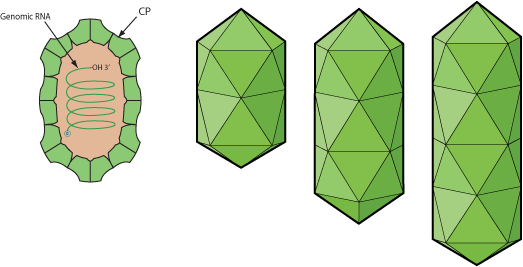Oleavirus (taxid:154322)
VIRION

Non-enveloped, quasi-spherical, 26 nm in diameter, with a T=1 icosahedral symmetry and bacilliform (37, 43, 48 and 55 nm long and 18 nm wide). Three genomic and one subgenomic segments are encapsidated in distinct particles, resulting in several different types of virion.
GENOME
Segmented, tripartite linear ssRNA(+) genome composed of RNA1, RNA2, RNA3 kb. Each genomic segment has a 3' tRNA-like structure and a 5'cap.
GENE EXPRESSION
Genomic RNA serves as messenger RNAs. RNA1 and RNA2 encode respectively proteins 1a and 2a, both involved in genome replication and internal transcription of sgRNA4 from the minus-strand copy of RNA3. RNA3 and sgRNA4 are translated respectively into movement and capsid proteins.
ENZYMES
REPLICATION
CYTOPLASMIC
- Virus penetrates into the host cell.
- Uncoating, and release of the viral genomic RNA into the cytoplasm.
- Expression of protein 1a and 2a to produce replication proteins.
- Replication occurs in viral factories made of membrane vesicles derived from the ER (spherules). A dsRNA genome is synthesized from the genomic ssRNA(+).
- The dsRNA genome is transcribed/replicated thereby providing viral mRNAs/new ssRNA(+) genomes.
- Subgenomic RNA4 is translated producing capsid proteins.
- Assembly of new virus particles.
- Viral movement protein triggers the formation of tubular structures that mediate virion cell-to-cell transfer via a tubule-guided mechanism.
Matching UniProtKB/Swiss-Prot entries
(all links/actions below point to uniprot.org website)4 entries grouped by strain
4 entries
Olive latent virus 2 (isolate Italy) (OLV-2) reference strain
Olive latent virus 2 (isolate Italy) taxid:650489
| Protein | ModelArchive |
| RNA-directed RNA polymerase 2a (protein 2a) (EC 2.7.7.48) | ma-jd-viral-18927 |
| Replication protein 1a | ma-jd-viral-38450 |
